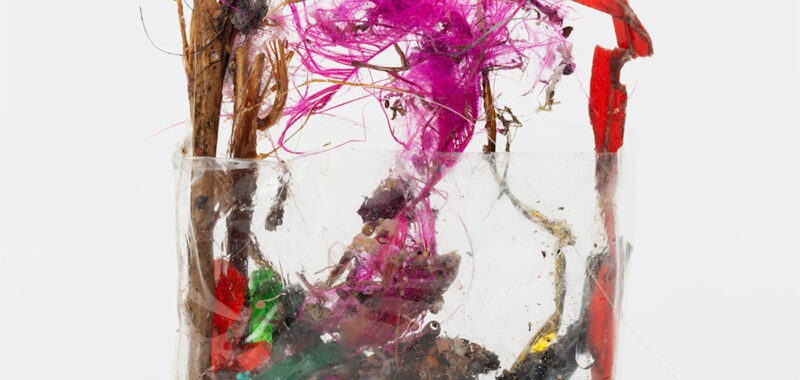Outside 101 Spring Street in Soho, pedestrians noisily stream by. But inside this five-story historic space is a different world where the lingering aura of Donald Judd’s quiet presence resides. Judd purchased the building in 1968 and, along with a later residence in Marfa, Texas, it was his home until his death at age 65 in 1994.
The building can be toured by appointment, with the ground floor open to the public as an exhibition space on Fridays and Saturdays. When I visited, artist Yuji Agematsu and his assistant were installing his new show. Agematsu, with shaggy hair, gray beard, and glasses, moved with the quiet precision of a dancer. His hands seemed attuned to spidery movements, the particular minute pinches required of his practice. He hunched over a box neatly lined with American Spirit cigarette packages that held his tiny compositions — one for each day of the month, each month mounted on small white shelves he designed. The room would soon hold a full year’s worth of works (366), composites of walks, thoughts, gestures, remnants.

Since 1996, Agematsu has taken a two-hour morning walk every day in his adopted city of New York, jotting down notes and locations and picking up detritus along the way. When something snares his attention, he places it in the cellophane wrapper inside the cigarette box he carries in his shirt pocket. The first chosen object of the day “wakes up my eyes and I start to open up and find more,” he said. It also determines the direction of the next choice. When he gets back to his apartment, he considers the composition that has accumulated in the cellophane and begins slight manipulations before gluing things in place. He calls the compositions “zips,” borrowing a term from the painter Barnett Newman, perhaps acknowledging Newman’s adherence to verticality. The vertical gestures in Agematsu’s works, such as the stick of a lollipop, a tiny branch, or a dragonfly wing breaching the lip of the sleeve, are also important, representing uprightness, positivity, and self-respect.
Agematsu worked for the Judd Foundation as the general manager for 21 years. The harmony between the space and his zips lies within the concepts of care and intention, of both artists feeling and noticing minutiae such as the way light hits a passage of steel, or a certain moment or spot yields different material concerns.

With 366 objects in a room, I wondered if my attention would wane. But Agematsu’s compositions kept delivering distinctive jolts of unexpected convivence: A piece of burnt red string that wisps around a tiny branch, nestled in a forest floor of street compost — an orange scrap, a green something; another with a curled, dried orange peel surmounted by a tangle of coarse hair. Each work is part painting, part sculpture, part collage, part storage vessel of time and place. The impact of the zips lies with the formal qualities as well as the conceptual recognition of a beautiful goal: to honor every day, to bring reverence and discipline to this job of living, to acknowledge each human’s durational condition. Agematsu studied with the avant-garde jazz musician and polyglot Milford Graves, who taught him how the movement or rhythms of the body affect mental and creative output.
At the Harlem home of former gallery owner Gavin Brown, part two of this exhibition was underway. The ground floor is a finished gallery space where Brown periodically stages projects. When I visited, Agematsu was installing year 2023. He mentioned that as an immigrant who moved to New York City from Japan in 1980, he has experienced prejudice. Part of his relationship to detritus comes from valuing what others perceive as disposable. Musing on aspects of displacement, he wondered, “When a bottle of Heineken is on your shelf, it is one thing. When it is on the ground, it is completely another. Why?”
I noticed one significant interruption in the passages of zips. In September 2023, two cellophanes hold almost nothing: One contains a crumpled institutional paper; another holds a folded piece of gauze. Agematsu said he was in the hospital. Just a blip in the flow. He soon resumed his project, turning the overlooked into the extraordinary.




Yuji Agematsu: 2023–2024 is presented by the Judd Foundation and continues at the Judd Foundation space (101 Spring Street, Soho, Manhattan) and Gavin Brown’s space (229 Lenox Avenue, Harlem, Manhattan) through August 30. The exhibition was organized by Judd Foundation in collaboration with Agematsu and designed by Scott Ponik.

